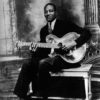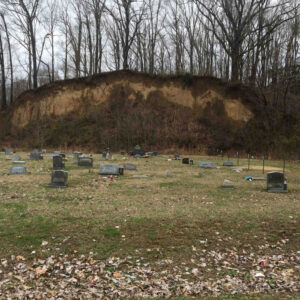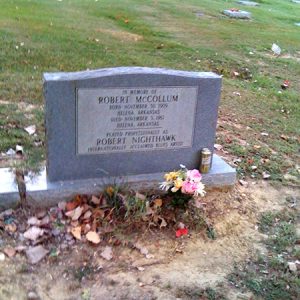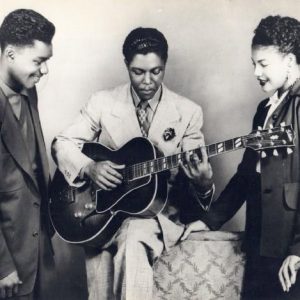calsfoundation@cals.org
Robert Nighthawk (1909–1967)
aka: Robert Lee McCollum
Robert Nighthawk was among the most remarkable slide guitarists in blues history, widely admired among his peers and the southern audiences he spent his life entertaining. Nighthawk influenced a generation of bluesmen such as Muddy Waters, B. B. King, Earl Hooker, and supposedly Elmore James. He was the archetype of the rambling bluesman, roaming all over the South with frequent trips to the North, though he chose Helena—present-day Helena-West Helena (Phillips County)—as his home base. This rambling nature and his decision to remain in the South likely explain why Nighthawk never achieved greater fame.
Robert Nighthawk was born Robert Lee McCollum in Helena on November 30, 1909, to Ned and Mattie McCollum. He was one of three children. His was a musical family that performed at dances, parties, and picnics. His first instrument was the harmonica, which he recalled picking up in 1924. Nighthawk married for the first time in 1928 to Mary Griffen in Friars Point, and they had two children. He was married a second time in 1947 to Hazel Momon, whom he met in 1945. They stayed together until 1953 and had three children.
Houston Stackhouse, who claimed to be Nighthawk’s cousin, taught him guitar in 1931. The two became lifelong friends and partners. Nighthawk soon began traveling around the Delta, where he met many fellow blues musicians. Between 1932 and 1935, he roamed farther afield, playing in the orchestra of the Dan Hildrege Show, traveling with singer Laura Dukes, and fronting a jug band in Memphis, Tennessee. During this period, he met and played with musicians such as Sleepy John Estes, Yank Rachell, Sonny Boy Williamson, Big Joe Williams, Hammie Nixon, “Big Bill” Broonzy, Memphis Slim, and John Lee Hooker.
After a run-in with the law in 1935, he moved to St. Louis, Missouri, where he remained through 1939. Nighthawk first surfaced on record in 1936, for Vocalion playing guitar on a four-song session with Jack Newman. A year later, pianist Walter Davis got Nighthawk signed to the Bluebird label. On May 5, 1937, Nighthawk made his debut as part of a historic recording session cutting six songs under his own name backed by Sonny Boy Williamson and Big Joe Williams. One of the songs was “Prowling Night-Hawk,” and it was this song’s popularity that was the basis for his name change in the early 1940s.
Nighthawk returned to the Bluebird studios in 1937 and 1938, cutting sixteen songs under his own name; he was also an in-demand session musician. In 1940, he returned to the studio, recording four songs for Decca including “Friars Point Blues,” his most polished slide work to date, a trademark he would become famous for in the postwar era.
Nighthawk was in Chicago, Illinois, around 1940–41 fronting his own band, but he was back in Helena by 1941. Nighthawk began playing electric guitar and refined his slide technique, drawing much inspiration from Tampa Red. In 1942, he got a spot on KFFA radio in Helena advertising for Bright Star Flour.
In 1948, Nighthawk landed his next recording contract with Aristocrat Records (soon to change its name to Chess) through the help of Muddy Waters, who was a star on the fledgling label. The following year, he cut five songs, including his most enduring record, the double-sided hit “Annie Lee Blues” backed with “Black Angel Blues.” In 1950, he recorded his final session for Chess. The following year, he moved over to the newly formed United label and its subsidiary, States. United recorded him on its very first day of sessions, and two of the label’s first five releases were listed as performed by “Robert Nighthawk & His Nighthawks Band.”
After his United recordings, Nighthawk returned to the South, staying mainly in the Helena/Friars Point area working with CeDell Davis, Sam Carr, harmonica player Frank Frost, and later Jack Johnson—the latter three backing him as the Nighthawks. A return to Chicago in 1964 resulted in several recordings; he cut songs for Chess, Testament, and Swedish Radio, who were in Chicago documenting blues, as well as two songs for a United Kingdom compilation album. He was also recorded and filmed live on Maxwell Street in conjunction with the filming of a 1964 documentary And This is Free. In 1965, he made an appearance in Toronto, Canada, where he recorded five songs in a small Toronto studio; these did not surface until 2006. In 1967, George Mitchell recorded Nighthawk for the final time in Houston Stackhouse’s combo, mostly playing bass due to ailing health.
Two months after these recordings, Nighthawk died of congestive heart failure on November 5, 1967, at the Helena Hospital. He is buried in Helena’s Magnolia Cemetery. “He loved Helena,” said Sam Carr. “That’s the reason I buried him there.”
For additional information:
Harris, Jeff. CD liner notes for Prowling with the Nighthawk. Document Records, 2004.
Jeff Harris
Rochester, New York
 Arts, Culture, and Entertainment
Arts, Culture, and Entertainment Blues Music
Blues Music Music and Musicians
Music and Musicians Magnolia Cemetery
Magnolia Cemetery  Robert Nighthawk Grave
Robert Nighthawk Grave  Robert Nighthawk
Robert Nighthawk 




Comments
No comments on this entry yet.